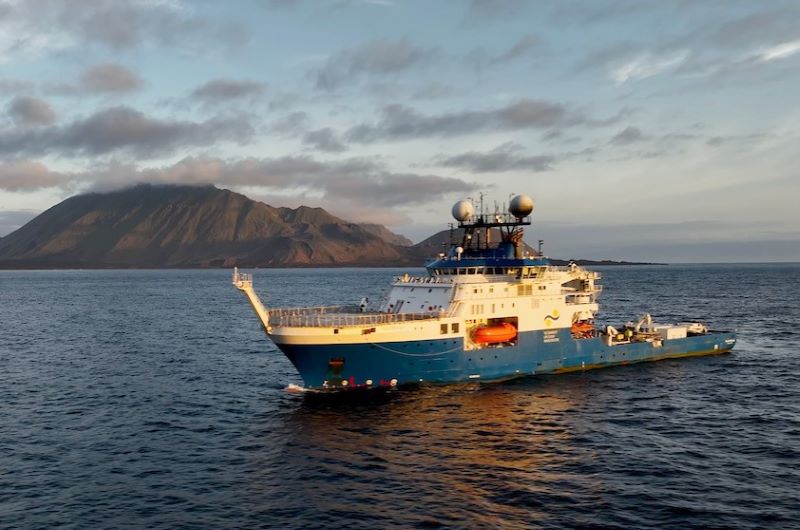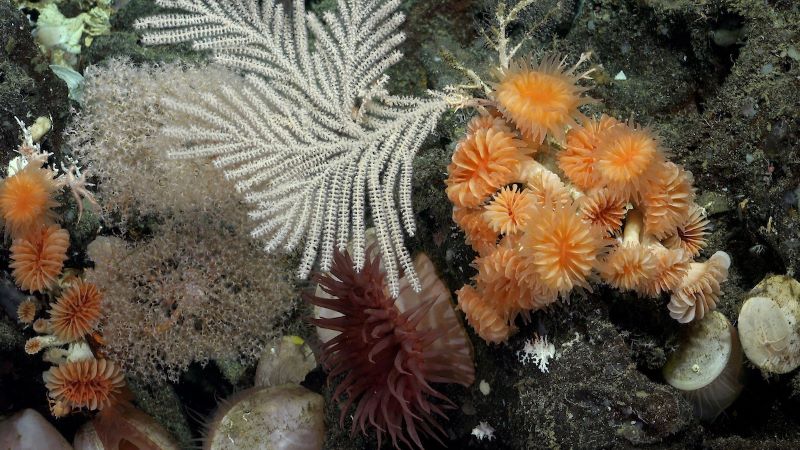
New discoveries in the Galápagos Islands
Scientists studying underwater ecosystems around the Galápagos Islands have discovered two pristine coral reefs and two uncharted seamounts. An international team of scientists aboard the research vessel Falkor (Too) used a remotely operated vehicle (ROV) named SuBastian to explore the waters around the islands. They found two cold-water reefs at depths from 1,200 to 1,375 feet (370 to 420 meters) teeming with life. Plus, they found two previously uncharted seamounts (underwater mountains), which had been suggested by satellite data. The Schmidt Ocean Institute announced the discoveries on October 26, 2023.
The larger of the newly found reefs in the Galápagos Islands Marine Reserve is more than eight football fields in length (about 730 meters). And the smaller reef is nearly three football fields in length (about 275 meters). The scientists found a rich diversity of stony corals. The discovery leads them to believe the coral has been supporting marine life here for thousands of years. Earlier this year, researchers found the first-ever deep coral reefs in this marine reserve. So these second and third discoveries will help in planning for the protection of this unique area. Danny Rueda Córdova, director of the Galápagos National Park Directorate, said:
This information is not only valuable from a scientific perspective, but it also provides a solid foundation for decision-making that effectively protects these ecosystems, safeguarding the biological diversity they harbor and ensuring their resilience in a constantly changing environment. The geological dynamics of the region play a fundamental role in the deep-sea ecosystems. Research and mapping are essential tools to ensure that the Galápagos continue to be an iconic example of the beauty and importance of nature.
The 2024 lunar calendars are here! Best Christmas gifts in the universe! Check ’em out here.
The Galápagos Islands
Of course, the Galápagos Islands off the coast of Ecuador are known for their diverse lifeforms found nowhere else on Earth. From giant tortoises to blue-footed boobies, the islands are famous for their unique species. And Charles Darwin’s studies in the Galápagos Islands helped him formulate his theory of evolution through natural selection.
The researchers were in the Galápagos scanning the underwater landscape with lasers to create extremely high-resolution maps of the coral reefs. The team was able to scan down to a two-millimeter (.04 inch) resolution. That precision allows them to identify animals living on the seafloor.

Coral reefs and seamounts
The month-long expedition began on September 18. In addition to the Galápagos, the team also explored around Isla del Coco National Marine Park, a protected area managed by Costa Rica. These islands are both in the Pacific, approximately 400 miles (630 km) apart.
The team compared the coral reefs and seamounts in the Galápagos to the Cocos Islands. One of their discoveries in the Costa Rican islands was multiple deep-sea coral reef species covered in eggs. Their studies will help guide management of the Eastern Tropical Pacific Marine Corridor, a network of interconnected marine reserves managed by the governments of Ecuador, Costa Rica, Panama and Colombia.
Expedition leader Katleen Robert of the Fisheries and Marine Institute of Memorial University of Newfoundland and Labrador said:
We are thrilled our mapping data are able to improve our understanding of reef ecosystems in the Galápagos. The interdisciplinary science team is excited that the data collected during this expedition will contribute to growing knowledge on the Galápagos National Marine Reserve and contribute to the management of the Eastern Tropical Pacific Marine Corridor.

Protecting deep-sea coral reefs
The researchers hope the knowledge they gained will be useful to areas all across the Eastern Pacific. The Charles Darwin Foundation’s Stuart Banks said:
The Galápagos Marine Reserve is an area of outstanding biological importance, connected to partner marine protected areas across the Eastern Pacific. Finding such deep and long-lived reefs takes us important steps closer to protecting hidden dimensions of ocean diversity and understanding the role that deep habitats play in maintaining our ocean’s health. These fascinating new findings continue to feed important research to inform better management of existing and future marine protected areas in the region.

Bottom line: Scientists on a research vessel exploring the Galápagos Islands discovered two deep-sea coral reefs and two previously uncharted seamounts.
Read more: Good news! Young tortoises spotted on Galapagos island
The post New coral reefs and seamounts discovered in the Galápagos first appeared on EarthSky.
0 Commentaires